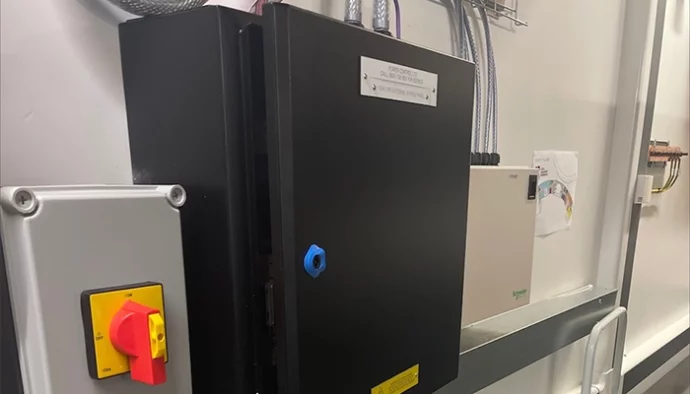How to Choose Between Single Phase v 3Phase UPS Installations
For some computer and server rooms, the most cost effective way to provide uninterruptible power protection is with a centralised UPS system. By this we mean installing a single UPS to power critical loads within the server racks, rather than to deploy individual uninterruptible power supplies within each cabinet.
Single UPS Installation
From a UPS installation point of view, let’s assume that the chosen UPS is 10kVA/10kW system, that the UPS will be installed with an external UPS maintenance bypass switch and that all the loads are single phase powered.
Most UPS manufacturers offer 10kVA UPS systems with a single-phase output. For some systems, their input supply can be configured at the time of installation to be either a single-phase input and single phase output (1/1), or a three phase input and single phase output (3/1).
External UPS Maintenance Bypass Switch
A UPS maintenance bypass allows switch allows the uninterruptible power supply to be disconnected electrically from the circuit supplying the critical load(s), without interruption. When in bypass mode, the loads are powered from the local mains power supply.
An external UPS maintenance bypass switch is different to an internal bypass arrangement. We would expect the 10kVA UPS to have an internal bypass. This will also power the critical load(s) from the mains power supply when in bypass mode, with EMC filtering, allowing the UPS to be inspected but not fully isolated from the electrical circuit. Again, the transfer to and from maintenance mode, will not disrupt the supply to the critical load(s)
The external UPS maintenance bypass switch must be installed to match the UPS configuration. For single phase loads there are two sizes available:
| Model | Configuration | Description |
|---|---|---|
| WBYP6311 | 1/1 | 10kVA (63A) Wall mount bypass switch 1:1 phase |
| WBYP6331 | 3/1 | 10kVA (63A) Wall mount bypass switch 3:1 phase |
WBYP stands for ‘wall mounted bypass switch’. A rack mounted version of the WBYP model would be an RMB631 for example.
At 10kVA, the UPS is hardwired. To help prepare for the UPS installation, the bypass switch is often sent to site ahead of the uninterruptible power supply, for the site electrician or electrical contractor to install.
The bypass will be supplied with a mains power supply, have two tails (one for the UPS input and one for the UPS output) and will power a local distribution board to which the critical loads will be connected. Either hardwired directly, or via Commando type sockets.
Single Phase v Three Phase Input Supplies
When designing a UPS installation, why would you choose a single-phase input over a three phase input and vice-versa? The answer lies in the supply available (single or three phase) and the rating available (Amps).
A 10kVA UPS system will supply at 230Vac 43.48Amps (see our UPS VA v Watts v Amps comparison table). A UPS input supply will higher than the output, as power is required to charge the battery and a small amount is lost by even the most energy efficient UPS systems.
For a typical 10kVA UPS such as the CertaUPS 650 10kVA, the input supply required would typically be from 54 to 63A dependent upon the size of the UPS charging circuit and size of battery connected. The UPS input should also be protected with a suitable circuit breaker in terms of the size and type (motor-rated). It is important to note that a typical 10kVA UPS can withstand an overload of say 150% for 0.5seconds before it will transfer the critical load(s) to the raw mains supply via a built-in automatic bypass arrangement.
To makes the maths easier, let’s take 60A amps as a mid-point between 54 and 63 for the input supply. For single-phase supply 60A at 230Vac, the input supply required is 13800VA or 13.8kVA. This means that the single-phase input supply cabling and discrimination should be sized for 13.8kVA. Using a three-phase supply, allows this loading to be split across the three-phase i.e. 20Amps per phase at 230Vac = 4600VA or 4.6kVA. Meaning smaller cable and discrimination and potentially a lower cost installation.
A three-phase input to the UPS therefore allows the UPS supply/load to be powered across the three-phase. A single-phase input places the total load onto a single cable. An electrician or electrical contractor normally helps to guide the choice.
3Phase UPS Installations
It is not unusual to find that some IT server loads requiring a three-phase supply, especially in a data centre environment. In this instance a 3phase input and output (3/3) UPS configuration is required. Multi-installation type systems may be available for any given UPS brand. An example being the CertaUPS C750 10kVA UPS which can be configured on installation for a 1/1, 3/1 or 3/3 type supply.
| UPS | Single Phase Input | Three Phase Input |
|---|---|---|
| C750 10kVA | 64A | 22A per phase |
The external maintenance bypass switch must also be suitable. For a CertaUPS C750 UPS that can be configured for one of three configurations, we have to add a third option to the bypass table (the WBYP3233).
| Model | Configuration | Description |
|---|---|---|
| WBYP6311 | 1/1 | 10kVA (63A) Wall mount bypass switch 1:1 phase |
| WBYP6331 | 3/1 | 10kVA (63A) Wall mount bypass switch 3:1 phase |
| WBYP3233 | 3/3 | 10kVA – 15kVA (32A) Wall mount bypass switch 3:3 phase |
For a typical 10KVA UPS, with three possible configurations available, it is important to discuss and plan for the electrical works at an early stage of the UPS project. Often this will require discussion with the site electrician or third-party electrical contractor. All electrical works must be undertaken and certified by a suitably qualified person (ECA or NICEIC member).
Summary
It is easy to plan a UPS installation once the critical load(s) have been sized. Often a single line diagram (SLD) is drawn up to determine the connection points and map out the positions of the loads, distribution boards, UPS maintenance bypass switch and the UPS system itself. This diagram can also provide other information including UPS, battery cabinet and UPS bypass switch dimensions, and the supply ratings required. For more information on planning a UPS installation for a server room or data centre, please contact our projects team.


























